Easy Sourdough Starter
This Easy Sourdough Starter recipe creates gorgeously fluffy homemade products such as Sourdough Baguettes. Included are simple step by step instructions on how to start, feed and Maintain Sourdough Starter that is perfect for beginners.
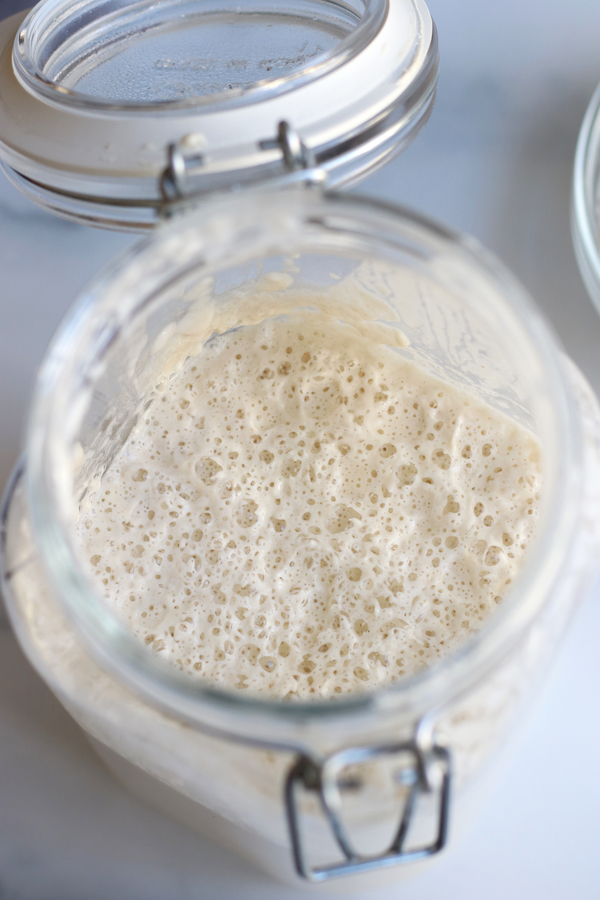
This post may contain affiliate links which I earn a small portion in sales if a purchase is made. Rest assured though, it is never at any additional cost to you.
What is Sourdough Starter
Very simply, sourdough starter is a fermented mixture of two ingredients, water and flour. Wild yeast found in flour flourishes when added to water and is allowed to rest in between feedings. This approach is the old fashioned way of making bread that has been done for centuries. It does require more time than active-dry or instant yeast but produces exceptional taste and textured baked goods.
Tools Needed
In addittion to the flour and water a few tools are needed to make your own from scratch Sourdough Starter.
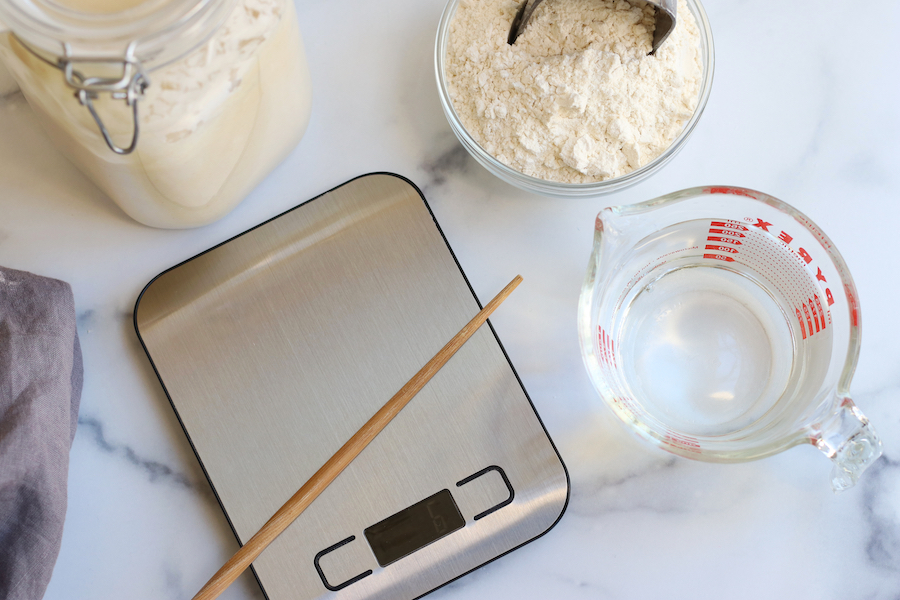
- Kitchen Scale- It is highly encouraged to use a kitchen scale to weigh the flour and water in equals parts to achieve the best results. This is the scale shown in the picture above. However, my next kitchen scale will be a little larger to accommodate the large bowl needed to make sourdough bread.
- Chopsticks– This makes stirring the starter in a glass jar much easier.
- Glass Measuring Cup– Makes for easy pouring of water.
- Scoop or Spoon– Helps with the addittion of flour.
- Medium Sized Glass Bowl– The first few days of a starters life is easier done in a medium size glass bowl.
- Plastic Wrap or Reusable Food Wraps– For the first few days of the starters life.
- Glass Jar (see below)
Sourdough Starter Container
The type of glass jar needed will depend on which type of flour you use to make your starter and how rapidly your starter ferments. This is the jar seen in the photo below and it works beautifully when using white all-purpose flour. Please see section directly below (White Flour vs Wheat Flour) for more explanation.
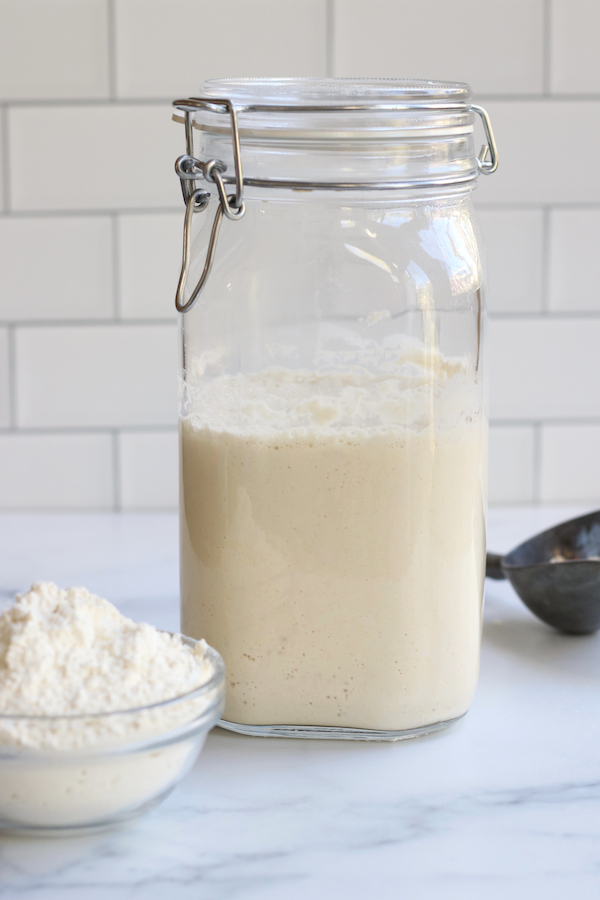
Best Flour for Sourdough Success
For the best sourdough starter, you need flour you can trust. Buying directly from King Arthur Flour means guaranteed freshness, expert-tested quality, and no risk of warehouse mishandling. Plus, you’ll find exclusive products, better stock availability, and support an employee-owned company dedicated to bakers. Skip the third-party markups and get the best right from the source. You and your sourdough deserve it! (affiliate)
White Flour vs Wheat Flour
The type of flour used will have a great influence on how your Stater ferments and the final product that you make with it. However, it is most important to not choose bleached flour as this will impede the fermentation.
All-Purpose White Flour
I adore sourdough bread that bites me back when I eat it. In other words, extra sour with a tang. However, my husband HATES that kind of bread. That is why I use all-purpose white flour for my Starter.
This type of flour yields breads that are very much like a crusty Italian loaf that he and I both go crazy for. Additionally, I use the Starter from this type of flour for making baguettes that then make incredible Homemade Breadcrumbs and croutons. The final products are never overly sour.
Wheat or Rye Flour
Wheat and rye flour has more naturally occurring wild yeast. Because of this, the starter made from these types of flours will ferment faster and with more intensity. It is very important to keep a closer eye on Starters made from these flours and to use a glass jar that has a lid that is looser or can be left slightly open. The reason for this, a tight fitting lid could be a recipe for an exploding jar.
In conclusion, wheat and rye flours will make much stronger sourdough products and all-purpose white flours (unbleached) will yield more mild final products.
How To Make
To make Sourdough Starter that is ready to bake with will take approximately 7 days, give or take a day or two. Here are the instructions for each day.
Day 1
In a medium sized glass bowl mix together 50 grams of water and 50 grams of flour. Stir well and cover. Let sit at room temperature.
Pro Tip#1– To accurately weigh the flour and water start by making sure the scale is weighing in grams vs ounces. Place the bowl on the scale and turn on. The scale should read zero with the the bowl on top. Add enough flour to equal 50 grams. Calibrate the scale back to zero again and repeat with water.
Pro Tip#2– In the making and feeding of this starter there will always be equal parts of flour and water added to it.
Day 2
To yesterday’s mixture add 50 grams of flour and 50 grams of water. Stir well and cover. Let sit at room temperature.
Day 3
Throw away half of the Starter. To the remaining Starter add 100 grams of flour and 100 grams of water. Stir well and cover. Let sit at room temperature.
Pro Tip#3– The discarded Starter from day 3- day 6 is not fully developed enough to have any uses. Simply throw it away.
Day 4
Throw away half of the starter. Add 150 grams of flour and 150 grams of water to the bowl and stir well. Cover and let sit at room temperature.
Pro Tip#4– Day 4 is the day that you will notice the mixture starting to take on the personality of a Sourdough Starter. There should be small bubbles and a slight sour smell will start to take shape.
Day 5
Similar to the previous days, throw away half of the Starter and add 150 grams of flour and 150 grams of water. Stir well, cover and let sit at room temperature.
Pro Tip#5– The Starter should begin to look very similar to picture A below. If not do not worry, it will very soon. Also, feel free to transfer to the glass jar once the new flour and water its mixed in on day 5.
Day 6
Throw away half of the starter and add 200 grams of flour and 200 grams of water. Stir well, cover and let sit at room temperature.
Pro Tip#6– By day 6 the Starter should look similar to photo A below and very possibly look like photo B.
Day 7
On day 7 the Starter should at the least look like photo B if not like photo C. If it has a similar appearance to photo C, it is ready to use. If it looks like photo B, let it sit at room temperature for one additional day.
Feeding and Reviving Sourdough Starter
Above all, if your Starter looks like photo C it is ready to be used for making all kinds of sourdough products. If it looks like photo B, you can still use it for baking. However, it will slow down the rising of bread dough. When it looks like photo A, it is time to feed the Starter.
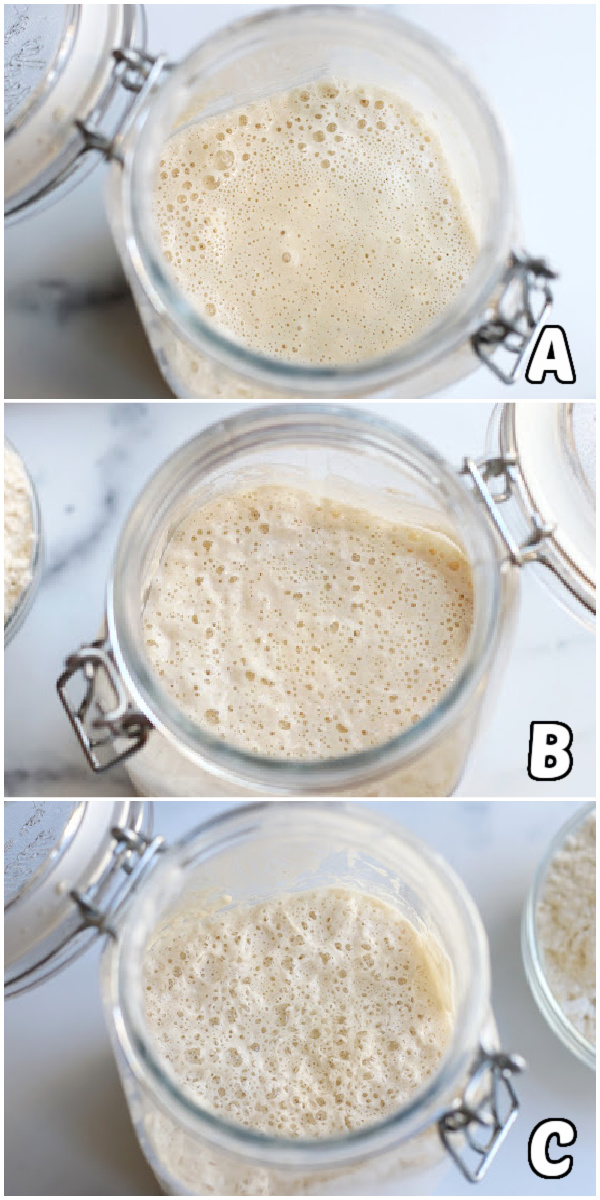
To feed the Sourdough Starter, discard half of it and add 150 grams of flour and 150 grams of water to the remaining Starter. Stir well and let sit at room temperature overnight. If on the second day the Starter has the appearance of photo B, let it sit at room temperature for one additional day before using it in recipes.
Pro Tip#7– If storing the Starter at room temperature it will need to be fed every 2-3 days. If storing in the refrigerator, it can be kept safely for up to 10 days before feeding. Please note that if storing in the refrigerator 2 feedings will most likely be needed before the Starter will look like photo C.
Starter Smell and How to Know if it has Gone Bad
A healthy Sourdough Starter is going to smell sour. Therefore, it is not the best way to judge whether it has gone bad. However, the best way to know is by its appearance. If there are any visible signs of mold or red/orange spots it is time to throw the Starter out and begin again. Take heart though, Sourdough Starters are full of good bacteria. Because of this, chances of it going bad are much lower.
Maintaining Sourdough Starter
For anyone new to sourdough baking, it is incredibly normal to have many questions and concerns about maintaining your sourdough starter. How To Maintain Sourdough Starter has a complete breakdown of the feeding schedule, common concerns and questions so that you can enjoy your sourdough starter for decades to come.
If you enjoyed this Sourdough Starter please let me know by leaving a comment and review below. Doing so helps to encourage others to make the recipe also. Thank you!
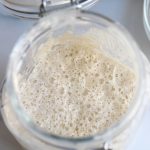
Easy Sourdough Starter
Ingredients
- 700 grams white all-purpose flour *see Note #1 below
- 700 grams filtered water
Instructions
Day 1
- In a medium sized glass bowl mix together 50 grams of water and 50 grams of flour. Stir well and cover. Let sit at room temperature.See Note #2 and Note #3 below.
Day 2
- To yesterday’s mixture add 50 grams of flour and 50 grams of water. Stir well and cover. Let sit at room temperature.
Day 3
- Throw away half of the Starter. To the remaining Starter add 100 grams of flour and 100 grams of water. Stir well and cover. Let sit at room temperature.See Note #3 below.
Day 4
- Throw away half of the starter. Add 150 grams of flour and 150 grams of water to the bowl and stir well. Cover and let sit at room temperature. See Note #4 below.
Day 5
- Similar to the previous days, throw away half of the Starter and add 150 grams of flour and 150 grams of water. Stir well, cover and let sit at room temperature. See Note #5 below.
Day 6
- Throw away half of the starter and add 200 grams of flour and 200 grams of water. Stir well, cover and let sit at room temperature. See Note #6 below.
Day 7
- On day 7 the Starter should at the least look like photo B above if not like photo C. If it has a similar appearance to photo C, it is ready to use. If it looks like photo B, let it sit at room temperature for one additional day.

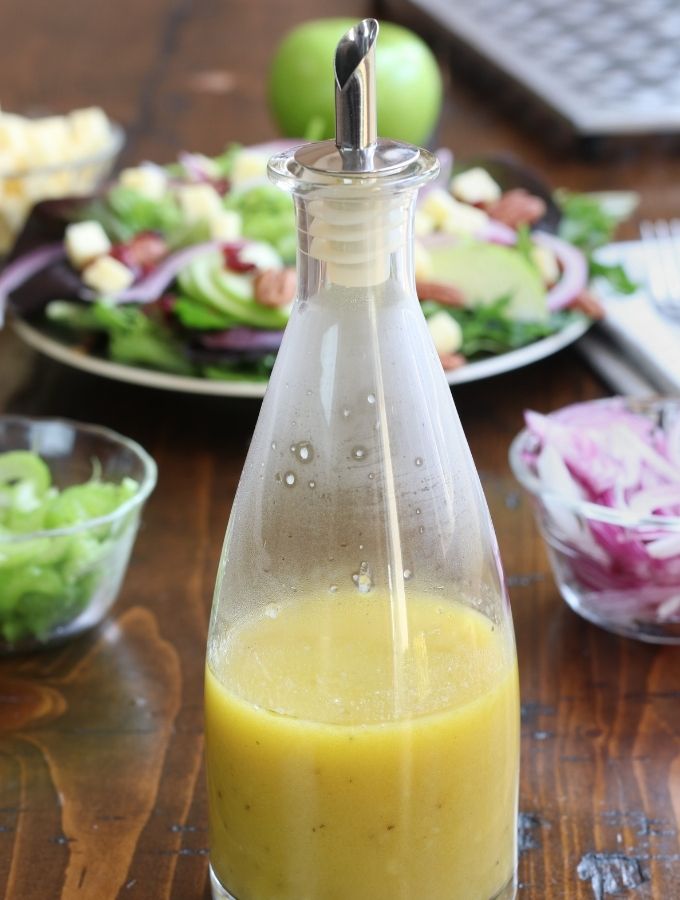


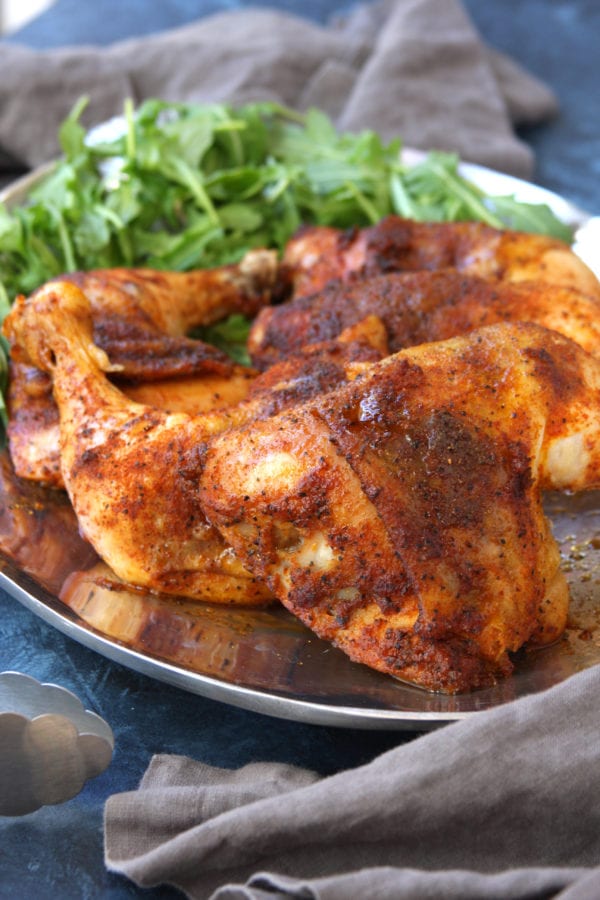
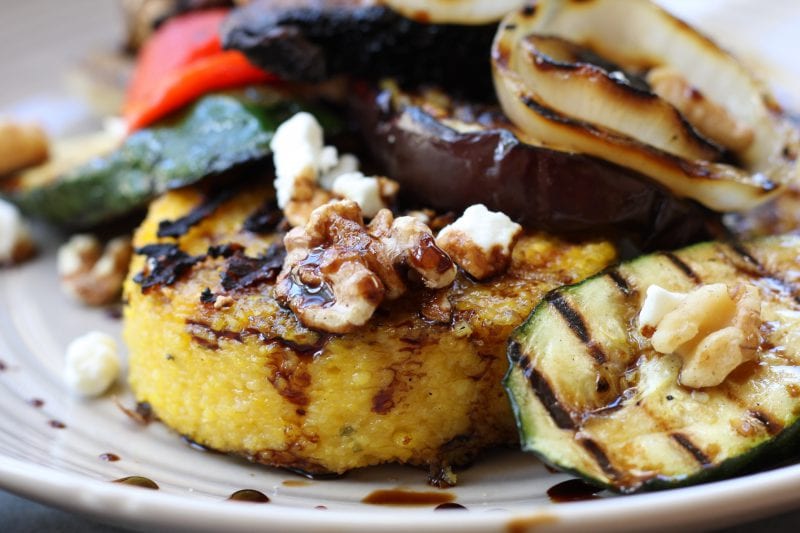
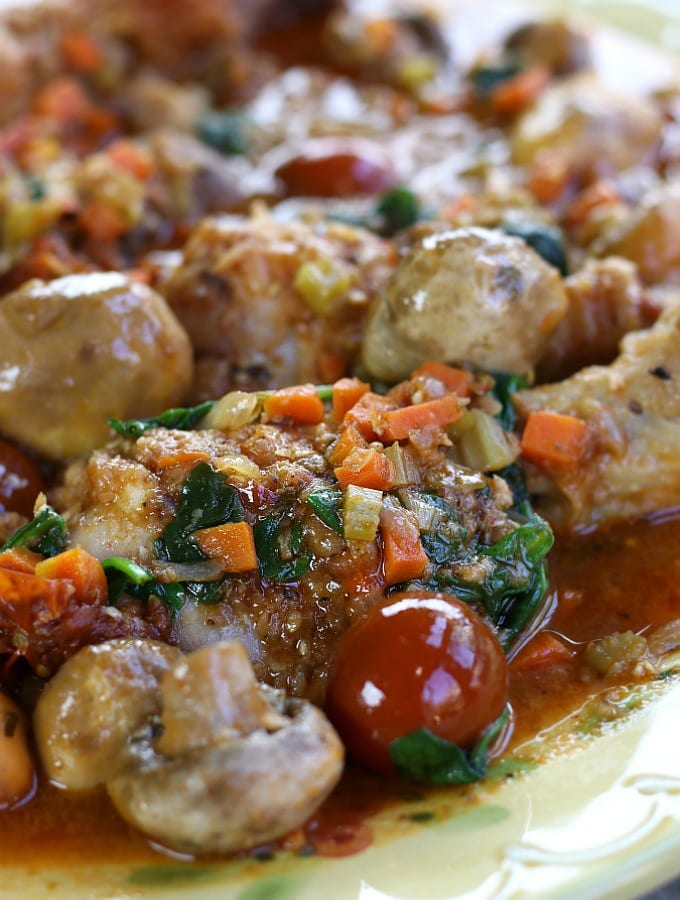
I made a mistake right off the bat I think. Eventough I read through your instructions I went ahead and starters my starter with 700 grams of flour and 700 grams of water. What should I do?
Hi Sherri! No worries at all. Mistakes happen, especially when tackling something new like a sourdough starter! Since you’ve started with a much larger amount, you can still make it work. Treat it as your Day 1 mixture and continue feeding it as outlined in the recipe. On Day 2, be sure to discard a fair amount of the mixture, keeping only about 100 grams, and then feed it with equal parts flour and water (by weight). This will bring the starter down to a manageable size. The great news is sourdough starters are pretty forgiving, so you’re still on track. I hope this helps!
My personal opinion (I’m new at this) After reading this recipe and given that you started off heavy I would google to see if there’s any way to recover and still use what you have or throw it all away and start over.
Hi Antoinette! Thank you for sharing your perspective! It’s true that starting with a much larger amount can feel overwhelming, but the great thing about sourdough starters is their flexibility. Adjusting and scaling back, like I mentioned in my response to Sherri, can usually save the starter without needing to start over. However, I always encourage exploring what works best for each person. I appreciate you chiming in!
omg I had to read it several times I almost did the same thing
Thank you Brandi for bringing this up. How can I write the recipe so that it is not as confusing?
Hi! I have quite a bit of hooch on the top of mine and I am on day 6 I have not fed it today yet.
Hi India! Thank you so much for giving my starter a try. Seeing hooch on day 6 is completely normal, it’s just your starter’s way of telling you it’s hungry and ready to be fed. Simply stir it back in and continue with the feeding process as instructed. Sometimes, starters need an extra day or two of discarding and feeding before they’re fully ready to bake with, so you’re absolutely on the right track. I’d love to hear what you decide to bake first!
At what point does or can it go in the fridge and what’s the feeding if any after that? How long does it last?
Hi Laurie! Great question! There are a few variables to consider, and I cover them all in my post ‘How To Maintain Sourdough Starter.’ It includes feeding schedules for both young and mature starters, along with tips for troubleshooting and reviving a dormant starter. I hope you find it helpful! https://www.thefedupfoodie.com/how-to-maintain-sourdough-starter/
Brand new to sourdough starters. Does the throw away part have to be discarded or can it just be another starter? Not sure of the reasons behind throwing away versus having 2 sourdough starters?
Hi Becky! This is a great question. The discard can absolutely be used to start a second sourdough starter, but most people discard it to keep the process manageable. Maintaining two starters means double the feeding and care, which can become overwhelming. If you’re curious, you can always experiment with keeping the discard as a second starter or use the discard in recipes like pancakes or crackers. I hope this helps!
My sourdough doesn’t have bubbles like it shows, and i’mon day 5. why could that be?
Hi Faith! It’s normal for some starters to take a little longer to show bubbles. Factors like room temperature, water, or the type of flour used can affect activity. Keep feeding it daily, and if it’s not bubbly by day 7, try moving it to a slightly warmer spot, it should start perking up soon! Also, you may find my post about Maintaining Sourdough Starter helpful as it dives into many of the factors that impact starters. Happy baking! https://www.thefedupfoodie.com/how-to-maintain-sourdough-starter/
Hi! I’m on day 6 and forgot to discard half the starter before adding more flour and water! What should I do?
Hi Rachael! No worries, forgetting to discard happens sometimes, and it’s an easy fix. On your next feeding, go ahead and discard half before adding more flour and water. This will get your starter back on track by reducing the overall volume and ensuring the wild yeast has enough food to thrive. You’re still on the right path, it just may take a day or two longer. Happy baking!
Before I waste time and money, could this work with Bob’s Red Mill 1:1 gluten free flour? I’d love to try out sourdough but gave a gluten allergy and gluten free anything is expensive.
Hi Caty! I completely understand not wanting to waste time or money. While traditional sourdough starters thrive with regular wheat-based flour, gluten-free sourdough starters are absolutely possible, they just need a bit of extra care. Bob’s Red Mill 1:1 gluten-free flour isn’t ideal because it contains xanthan gum, which can affect the fermentation. Instead, I recommend using a single-ingredient gluten-free flour like brown rice or sorghum flour to start. Once it’s active, you can experiment with blends for baking. I hope this helps, and good luck with your gluten-free sourdough adventure!
Hi Heather! I wanna try this today, but I don’t have a glass jar, is it that important? or can I just use a hermetic plastic one?
Hi Maca! A glass jar is ideal because it’s non-reactive and lets you easily see your starter’s progress, but a plastic container can work too, as long as it’s food-safe and clean. If by hermetic you mean airtight, you’ll need to adjust it slightly—your sourdough starter needs some airflow to thrive. You can loosely place the lid on top or cover it with a breathable material like a clean cloth or paper towels secured with a rubber band. Happy baking, and I’m excited for you to start your sourdough journey!
I am on day 7 and it’s water with some foam bubbles. do I keep feeding it or start over.
Hi Tina! It sounds like your starter is very close to being ready for baking but just needs a few more days of discard and feeding. Just keep feeding it for a few more days. It should become bubbly and rise after feeding. No need to start over; it’s on the right track and just needs a little more time.
Do I have to increase the amount of flour and water I add or can I stick with 50g of each ? I’ve been repeating day 2 but and am on day 4 currently
Hi Madison! If you’re following the recipe and repeating day 2, that’s fine for now to help strengthen your starter. On day 4, though, it’s best to start following the outlined steps in the recipe to ensure your starter develops properly. Let me know if you need any clarification, I’m here to help! 😊
does the temperature of the water make a difference?
Hi Dawn! Yes, the water temperature can make a difference! Ideally, you want the water to be lukewarm, around 75-85°F (24-29°C). If the water is too hot, it can harm the natural yeast and bacteria in your starter, while water that’s too cold might slow down the fermentation process. Room temperature or slightly warm water works perfectly to keep your starter happy and active.
I hope this helps, and happy sourdough baking!
Yesterday day, on day 5, my starter more than doubled and “exploded” out of my jar. I cleaned it up and just continued with the process today for day 6. Well it’s been a few hours and it’s definitely doubled again, and I imagine it might continue. How do I stop it from making a mess, and what does this mean for my starter? Is it ready to use? Thanks!
Hi Jackie! It sounds like your sourdough starter is thriving beautifully! If it’s more than doubling and trying to escape its jar, it’s definitely ready to use. 🎉 To prevent any more “explosions,” I recommend transferring it to a larger container. I’ve linked my favorite container in the post—it works wonderfully for active starters like yours.
Keep feeding it as needed, and when you’re ready to bake, it should perform beautifully. I hope this helps, and happy baking!
Hey, can I use my starter on day 7 or when is it ready to be used?
Hi Luna, great question! You can start using your sourdough starter once it’s active, bubbly, and doubling in size after a feeding. For many people, this happens around day 7, but if it’s not quite there yet, give it another day or two and keep feeding it. The key is that it should look lively and smell pleasantly tangy. I hope this helps!
Hello.. on day 5 today.. can’t wait.. all is on track for me.
Question… can you add items to dough for flavors? Like cheese and jalopenos? or like honey? do you have some suggestions?
Thank you,
Jackie
Hi Jackie, I’m so glad your starter is on track—how exciting! You can absolutely add things like cheese, jalapeños, or honey to your sourdough for extra flavor, but if you’re new to baking sourdough, I recommend starting with a simple, basic recipe first to get a feel for the process. Once you’re comfortable, you can start experimenting with add-ins. Cheese and jalapeños make for a delicious savory loaf, and honey adds a lovely touch of sweetness and can be used in my Soft Sourdough Bread. I hope this helps, and happy baking!
Hey,
Im on day 7 and my starter has bubbles on its sides but none on the top yet. It doubles in size between feedings and shows every other sign of an active sourdough starter.
Is it ready to use or what do i do?
Hi Luna! It sounds like your starter is off to a great start! If it’s doubling in size between feedings and showing signs of activity, it’s likely ready to use. Sometimes, the bubbles on top can take a little longer to appear, especially if the jar is narrow or the starter is thick. You can test its readiness by doing a float test. Take a small spoonful of starter and drop it into a glass of water. If it floats, it’s active and ready to bake. If not, give it another day or two of feeding. I hope this helps!
All was going well doubling and bubbling until day 4.. I woke up to hooch. Mixed it in and continued, again hooch on day 5. I usually keep my house around 66/67. I put it in the oven with the light on but thinking this may have been wrong? I reviewed the how to maintain with hooch.. maybe I need to do 2 feedings? After feeding at 7a by 1p there are bubbles that cover the surface but it looks like it’s starting to separate at the edges.. and it’s not growing in size.
Hi Elizabeth! Thank you for sharing all the details, it’s super helpful for me! What you’re experiencing is completely normal, especially in the early days of starting a sourdough starter. The appearance of hooch and some separation just means your starter is hungry. Your house temperature of 66/67°F is actually great for developing a strong starter, it might just take a bit more time.
At this stage, patience is key. Keep feeding it once daily for now, and if you continue to see hooch or no growth, try feeding twice a day (morning and evening). Over the next few days, you should start noticing more consistent bubbles and growth. It’s all part of the process, and sourdough starters sometimes take a little extra time to hit their stride. You’re doing great, and I hope this helps!
Hi,
I am on day 7 and it’s bubbling some but not much. I did the float test and it isn’t floating. How much should I feed it?
Hi Jenn! If your starter is bubbling a little but not quite there yet, keep following the process of discarding half and feeding it 150g each of flour and water each day. It may just need a day or two more of the discard and feeding process before it is ready to bake with. You’re almost there. Just a little more time, and it’ll be ready to bake with!
I’m not sure if it’s already been asked, but I decreased my starter amount to 100g starter and added in 100g flour and 100g water. Tomorrow if I discard half it would leave me with 150g starter so would I add in 150g flour and 150g water? Wouldn’t this make it increase each day? How do I keep it small enough to fit in my mason jar (32oz) and keep it manageable.
Hi Madison! Great question! Yes, if you have 150g of starter after discarding, you would add 150g of both flour and water to feed it.
As this starter becomes bubbly and active, it will expand, so a larger jar like the one linked in the post is ideal for this recipe. As long as you discard before feeding, the larger jar will work perfectly. I hope this helps!
Extremely easy to make. I have really enjoyed the step by step instructions. I have already made 4 loaves of bread and 70 pretzel bites. Going to try the english muffins and the bagels next. Greetings from Montana!
Hi James! That’s amazing and you made my day! I’m so glad you’ve found the instructions helpful, and it sounds like you’ve been busy baking up a storm, four loaves of bread and 70 pretzel bites? That’s impressive! I love that you’re diving into new recipes like English muffins and bagels next. Greetings to you in beautiful Montana, and happy baking!
I started my starter yesterday so it’s only just been 24 hours but I noticed that it’s a bit thick looking. I purchased a weigh scale and zeroed it off to measure the bowl, the zeroed to add the water and then zeroed to add my flour. I noticed that you picture A looks looser than mine and now I’m wondering if maybe I used the wrong type of flour. I used Robinhood All Purpose White flour. Any advice? Thanks!
Hi Leah! Great question, and it sounds like you’re doing everything right so far! It’s normal for some starters to look a bit thicker, especially in the first 24 hours, and flour type can definitely play a role. Robinhood All Purpose White Flour should work just fine, but it might absorb a bit more water than other brands. To loosen it up, you can add a small splash of water (just a teaspoon or two) and give it a good stir until it reaches a consistency like thick pancake batter.
Also, just to clarify—my Picture A is about 5 or 6 days into the process when the starter is much more active and bubbly, which can make it look looser. At the beginning, it’s totally normal for it to be a bit thicker as it gets going. You’re off to a great start, and I hope you enjoy seeing your starter come to life!
Can you use unbleached bread flour?
Hi Kristi! Great question! Yes, you can absolutely use unbleached bread flour for your sourdough starter. In fact, the higher protein content in bread flour can provide a bit more structure and activity for your starter as it develops. If you would like to switch up flours later down the road, just keep an eye on the hydration level. Different flours absorb water differently, so you may need to adjust the water slightly to maintain the right consistency, which should be like a thick pancake batter or smooth paste. I hope you enjoy and please don’t hesitate to reach out with any questions.